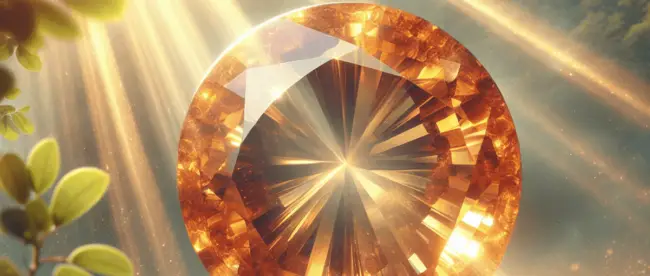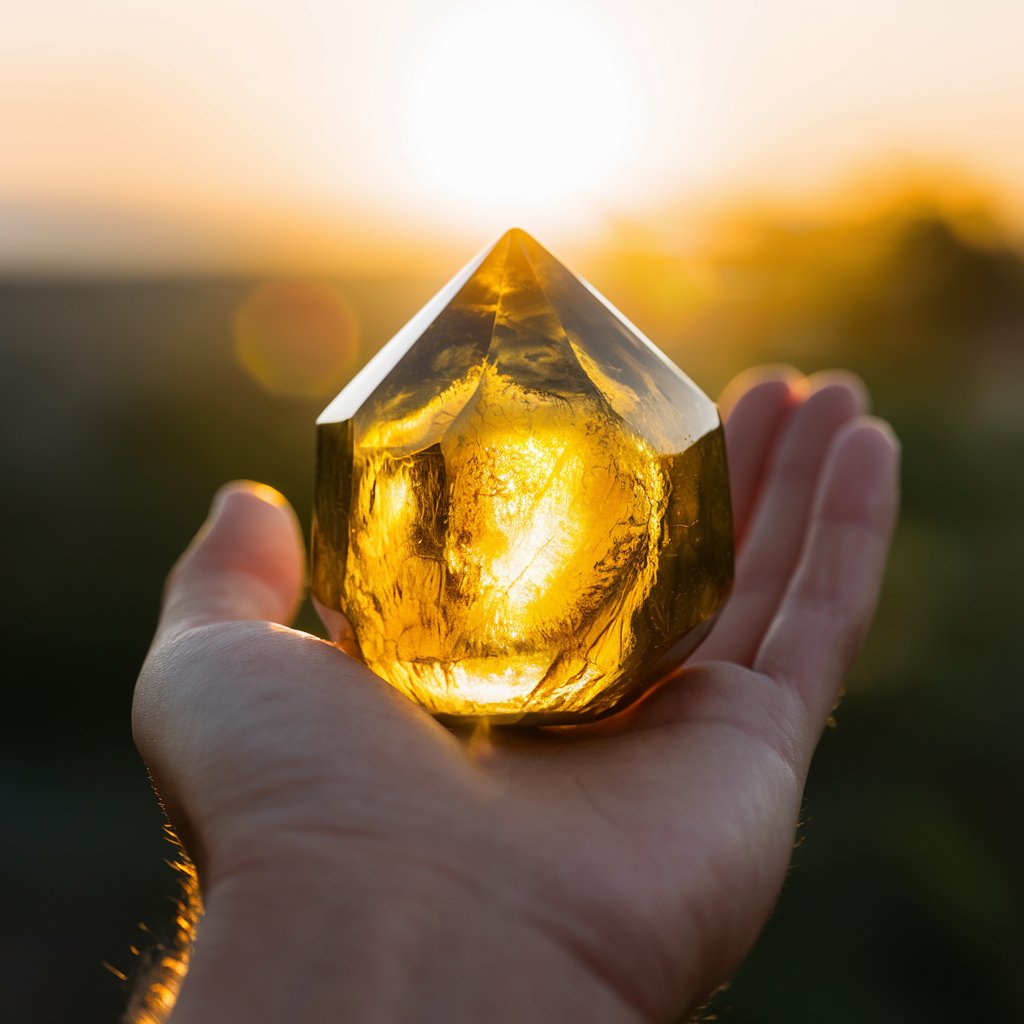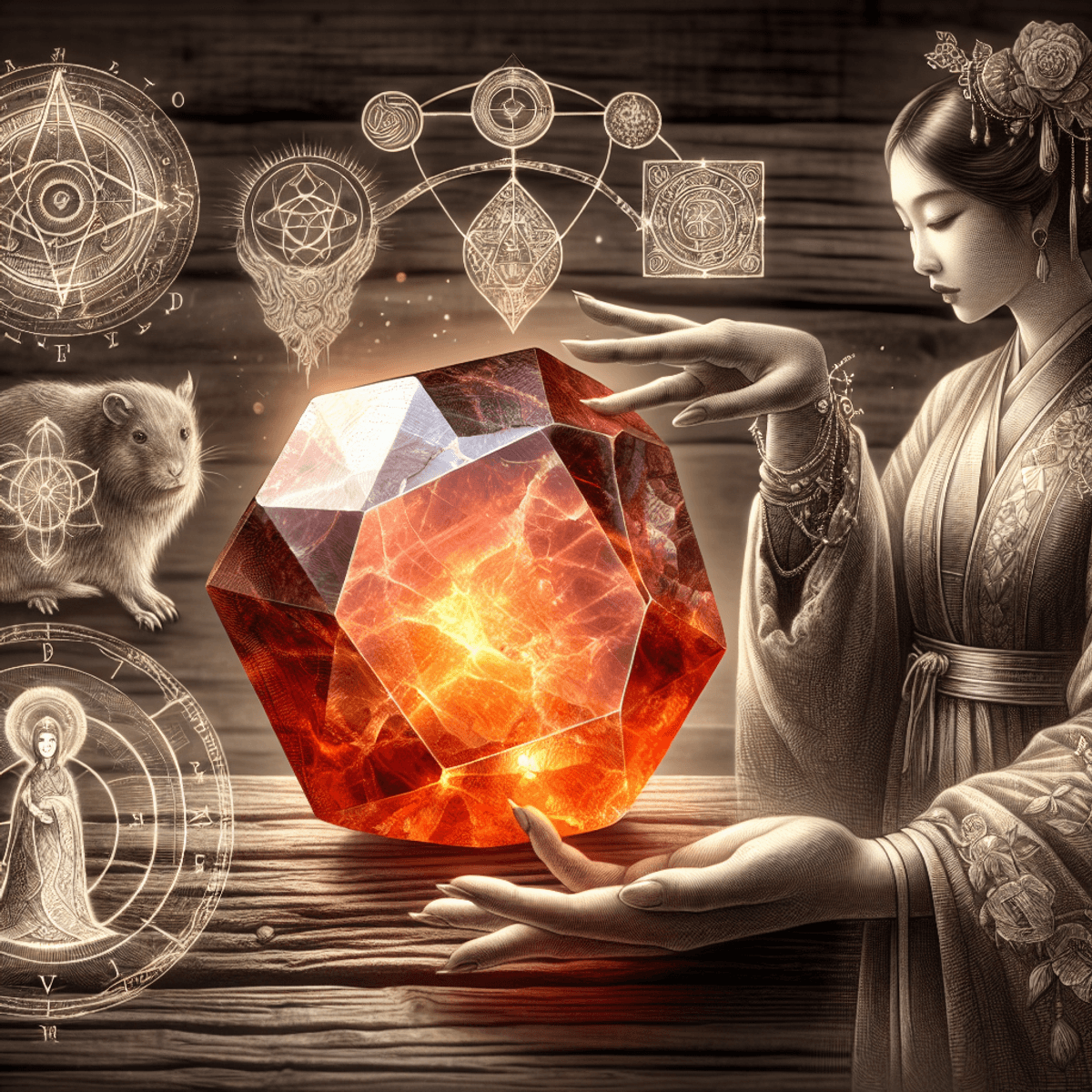Heliolite (also Known as Sunstone): Meaning, Benefits and History

Heliolite, commonly known as sunstone, is a captivating gemstone that has fascinated humanity for centuries. This gem, part of the feldspar group, is celebrated for its aventurescence—a shimmering effect caused by reflective inclusions of hematite or goethite. The name heliolite originates from the Greek words “Helios” (sun) and “Lithos” (stone), perfectly capturing its radiant beauty and solar connections.
Studying gemstones like heliolite is more than an exploration of their physical attributes. These stones carry with them rich histories, cultural significance, and a range of purported benefits that span both the metaphysical and physical realms. Delving into the world of gemstones opens up pathways to understanding different cultures, spiritual practices, and even aspects of our own well-being.
In this article, we will explore heliolite’s meaning, benefits, and history. From its classification within the feldspar group to its significant role in ancient navigation techniques, we will uncover the various layers that make sunstone not just a beautiful mineral but a symbol of light and warmth throughout human history.
Do you have a specific interest in Heliolite properties and meaning? Then use the table of contents below to jump to the most relevant section. And you can always go back by clicking on the black arrow in the right bottom corner of the page. Also, please note that some of the links in this article may be affiliate links. For more details, check the Disclosure section at the bottom of the page.
Here's what we'll cover:
- Understanding Heliolite (Sunstone)
- Historical Significance of Heliolite aka Sunstone
- Geographical Distribution and Mining Locations of Sunstone
- Metaphysical Properties of Heliolite/Sunstone
- Healing Benefits and Chakra Connection of Heliolite
- Symbolism and Cultural Significance of Heliolite/Sunstone in Different Traditions
- Conclusion
Understanding Heliolite (Sunstone)
Heliolite, more commonly known as Sunstone, is a member of the feldspar group of minerals, which is one of the most abundant mineral groups on Earth. Feldspars are a family of silicate minerals that share a common structure and similar chemical compositions. Heliolite specifically falls under the plagioclase feldspar subgroup.
Chemical Composition and Physical Characteristics
The chemical composition of heliolite consists predominantly of aluminum, silicon, and oxygen, with varying amounts of sodium and calcium. This gives rise to its unique physical traits:
- Color: Sunstones exhibit a spectrum of colors ranging from pale yellow to deep red, with some even displaying greens and blues. Notably, there are pink sunstone varieties that add to this vibrant palette.
- Aventurescence: One of the most striking properties of heliolite is its aventurescence. This shimmering effect is due to tiny inclusions of hematite or goethite within the stone, which reflect light in a captivating manner.
- Hardness: On the Mohs scale, heliolite ranks between 6 and 6.5, making it relatively hard yet suitable for various types of jewelry.
Crystal System and Its Significance
Heliolite crystallizes in the triclinic crystal system. Each crystal system has unique symmetry and geometric properties that determine how a mineral forms and grows:
- Triclinic System: This system is characterized by three unequal axes that intersect at oblique angles. Minerals in this system often have complex internal structures.
- Significance: The triclinic nature contributes to the optical phenomena observed in sunstone, including its aventurescence. These internal reflections can create stunning visual effects that enhance its appeal.
Understanding these fundamental aspects not only sheds light on what makes heliolite so unique but also allows us to appreciate its role in both historical contexts and modern applications. The intricate dance between its chemical composition, physical characteristics, and crystal structure creates a gemstone that continues to captivate enthusiasts worldwide.

Historical Significance of Heliolite aka Sunstone
The history of sunstone reveals its profound impact across various cultures and eras.
Ancient Egypt and Greece
In ancient Egypt, sunstone was often linked to the solar deity Ra, embodying the essence of the sun’s life-giving energy. Egyptians believed it held protective qualities, using it in amulets and talismans to safeguard against harm. Similarly, in Greek mythology, sunstone was associated with Helios, the god of the sun. The Greeks revered it for its perceived ability to harness sunlight, believing it could bring prosperity and dispel darkness.
A fascinating chapter in the historical significance of sunstone is its role in Viking navigation techniques. Vikings reportedly utilized this gemstone as a navigational aid during their sea voyages. Known as a “sun compass,” the stone could polarize light, helping sailors determine the position of the sun even on overcast days or when the sun was below the horizon. This method was crucial for their long-distance travels across the North Atlantic.
Renaissance Magic
During the Renaissance period, sunstone found a place in magical rituals and alchemical practices. Alchemists saw it as a symbol of enlightenment and transformation. They integrated it into their work, believing it could channel celestial energies and unlock hidden knowledge. Renaissance magicians used sunstone in rituals aimed at invoking solar deities and acquiring divine insight.
The history of sunstone thus spans from ancient civilizations to medieval Europe, each era attributing unique significance to its shimmering allure. Whether as a protective amulet, navigational tool, or mystical element in magical rites, sunstone’s legacy continues to captivate those who seek its radiant energy.

Geographical Distribution and Mining Locations of Sunstone
Sunstone’s appeal goes beyond its stunning beauty; it is also found in various regions around the world. This gemstone can be found on multiple continents, with each location contributing its own distinct qualities to the stone.
Major Mining Sites
Here are some of the key countries where sunstone is mined:
- Norway: Known for producing sunstones with a striking aventurescence, Norway has a long history of sunstone mining.
- Russia: Russian sunstones often showcase a deep, rich color and are highly sought after for their quality and beauty.
- Canada: In Canada’s vast landscapes, sunstones are mined primarily in Labrador, adding to the country’s diverse mineral wealth.
- India: Indian sunstones come in a variety of hues and are an important part of India’s gemstone market.
Oregon: The State Gem
Since 1987, Oregon has held the distinction of naming sunstone as its state gem. Oregon sunstones are particularly renowned for their vibrant colors ranging from pale yellow to deep red. The inclusions of copper within these stones create a mesmerizing effect that sets them apart from other varieties. This unique characteristic makes Oregon sunstones a favorite among collectors and jewelers alike.
Factors Influencing Sunstone’s Market Value and Rarity
Several factors contribute to the value and rarity of sunstone:
- Color: The warmth and depth of the color play a significant role, with red and pink varieties often commanding higher prices.
- Aventurescence: The shimmering effect caused by reflective inclusions enhances the stone’s appeal.
- Clarity: Clearer stones with fewer inclusions tend to be more valuable.
- Origin: Sunstones from specific locations like Oregon can add to their market value due to their unique properties.
The geographical diversity of sunstone mining locations contributes not only to the gemstone’s varied aesthetics but also to its rich cultural tapestry. Each region infuses its own essence into these captivating stones, making them truly special treasures of the earth.

Metaphysical Properties of Heliolite/Sunstone
Heliolite, or sunstone, has long been revered for its metaphysical properties. Enthusiasts in lithotherapy believe that this gemstone carries the essence of the sun, radiating warmth and positive energy.
Healing Benefits Associated with Reproductive Health and Wellness
The healing properties of sunstone are thought to extend to physical wellness, particularly in the realm of reproductive health. Historically, it has been used to:
- Enhance fertility: Many believe that sunstone can boost reproductive vitality and aid in conception.
- Alleviate menstrual issues: Sunstone is said to help regulate menstrual cycles and alleviate cramps.
- Support sexual health: The gemstone’s energizing qualities are thought to enhance sexual vitality and intimacy.
Connection to Chakras and Zodiac Signs
Sunstone’s connection to chakras adds another layer to its metaphysical significance. It is primarily associated with the:
- Base Chakra: Believed to ground and stabilize energy.
- Sacral Chakra: Enhances creativity, passion, and sensuality.
- Solar Plexus Chakra: Boosts confidence, personal power, and self-discipline.
For zodiac enthusiasts, sunstone holds special resonance with:
- Leo: Amplifies leadership qualities and self-expression.
- Libra: Promotes balance, harmony, and social connections.
Spiritual Symbolism
Sunstone’s shimmering inclusions are seen as a reflection of its spiritual symbolism. It is often associated with:
“Joy, warmth, benevolence, and light.”
Many use sunstone in meditative practices to invite these qualities into their lives. Surrounding oneself with heliolite can serve as a daily reminder of the inner light that each person carries.
These beliefs weave a rich tapestry around heliolite, making it not just a beautiful stone but a beacon for those on a spiritual journey.

Healing Benefits and Chakra Connection of Heliolite
Heliolite, or sunstone, is celebrated for its profound healing benefits. This gemstone resonates deeply with the physical body and energy centers, providing a holistic approach to well-being.
Physical Healing Benefits
- Reproductive Health: Heliolite is often associated with strengthening the reproductive system. It is believed to aid in regulating hormonal imbalances and enhancing fertility.
- Antiseptic Qualities: Traditional uses suggest that sunstone possesses antiseptic properties, making it beneficial for cleansing wounds and preventing infections.
- Vitality and Energy: Carrying the life-giving energy of the sun, heliolite can invigorate the body, boosting overall vitality and stamina.
Chakra Alignment
Sunstone’s unique vibrational frequency aligns with multiple chakras, facilitating balanced energy flow throughout the body.
- Base Chakra: Located at the base of the spine, this chakra governs our sense of security and grounding. Heliolite’s grounding properties help stabilize this energy center.
- Sacral Chakra: Positioned below the navel, this chakra influences creativity and sexual energy. Sunstone’s warm energies stimulate passion, creativity, and emotional balance.
- Solar Plexus Chakra: Found in the upper abdomen, this chakra is connected to personal power and confidence. Sunstone’s radiant qualities enhance self-esteem, willpower, and mental clarity.
Zodiac Connections
Heliolite’s energetic properties also resonate strongly with specific zodiac signs:
- Leo: Known for their fiery nature, Leos can harness sunstone’s vibrant energy to amplify their innate leadership qualities.
- Libra: Libras may find balance through heliolite’s harmonizing vibrations, aiding in decision-making and emotional equilibrium.
The interplay between heliolite’s physical healing benefits and its alignment with chakras creates a powerful tool for those seeking both spiritual growth and physical wellness.
Symbolism and Cultural Significance of Heliolite/Sunstone in Different Traditions
Sunstone symbolism weaves a rich tapestry across different cultures, each attributing unique meanings to this radiant gem. Often associated with good fortune and prosperity, sunstone has been revered for its vibrant energy and warm glow.
Symbolic Meanings Across Cultures
Native Americans
Native Americans believed sunstone held the spirit of the sun, bringing life and abundance to the earth. They used it in ceremonies to invoke the power of the sun, hoping for bountiful harvests and protection against harm.
Greek Mythology
Greek Mythology connects heliolite to Helios, the Sun God who drove his chariot across the sky daily. Wearing or carrying sunstone was thought to harness Helios’s strength and vitality, imbuing the bearer with courage and enthusiasm.
Eastern Traditions
In Eastern traditions, particularly in Indian culture, sunstone is seen as a harbinger of wealth and prosperity. It is often used in meditative practices to attract success and dispel negative thoughts.
 Myths and Legends Surrounding Heliolite
Myths and Legends Surrounding Heliolite
Viking legends tell tales of navigators using sunstones to find their way at sea on cloudy days. Believed to polarize light, these stones guided sailors by revealing the hidden position of the sun. This gave rise to stories of mystical stones that could metaphorically ‘see’ through storms.
Renaissance magic also embraced sunstone’s allure. Alchemists considered it a powerful conduit for solar energy, using it in rituals designed to bring enlightenment and spiritual awakening.
In Celtic folklore, heliolite was linked with healing powers. Druids would include it in their sacred rites, believing that its connection to the sun could cure ailments and renew one’s spirit.
Understanding these diverse cultural perspectives enriches our appreciation for heliolite’s multifaceted nature. Sunstone isn’t just a beautiful gemstone; it’s a bridge connecting us with ancient traditions and timeless wisdom.
Conclusion
Exploring the wonders of heliolite, or sunstone, invites a deeper connection with both history and the metaphysical realm. Whether you’re drawn to its shimmering beauty or inspired by its storied past, there is much to discover about this radiant gemstone.
Healing Benefits
The healing benefits of sunstone are vast, touching upon physical, emotional, and spiritual aspects. From enhancing reproductive health to balancing chakras, the stone’s energies can support a holistic approach to wellness.
Cultural Legends
The legends surrounding heliolite captivate the imagination. Stories from Viking navigators to Native American myths enrich our understanding of how this gemstone has been revered across different cultures.
Connecting with gemstones like sunstone isn’t just about appreciating their aesthetic appeal. It’s about tapping into their deeper meanings and potential benefits. Allow yourself to be curious and open-hearted as you explore these natural treasures. Whether for healing or simply as a beautiful addition to your collection, heliolite offers a unique opportunity for personal growth and discovery.
Feel encouraged to discover the healing benefits of sunstone and explore the legends surrounding heliolite in your own journey. Each stone holds a story—perhaps it’s time to find out how it resonates with yours.
Thanks for the blog graphics: Canva.com
Disclosure: At Buddhatooth.com we only mention the products that we’ve researched and considered worthy. But it’s important to note that we are a participant of several affiliate programs, including but not limited to VigLink and Amazon Services LLC Associates Program, an affiliate advertising program designed to provide a mean for us to earn fees by linking to Amazon.com and affiliated sites. As an Amazon Associate Buddhatooth.com earns from qualifying purchases.

